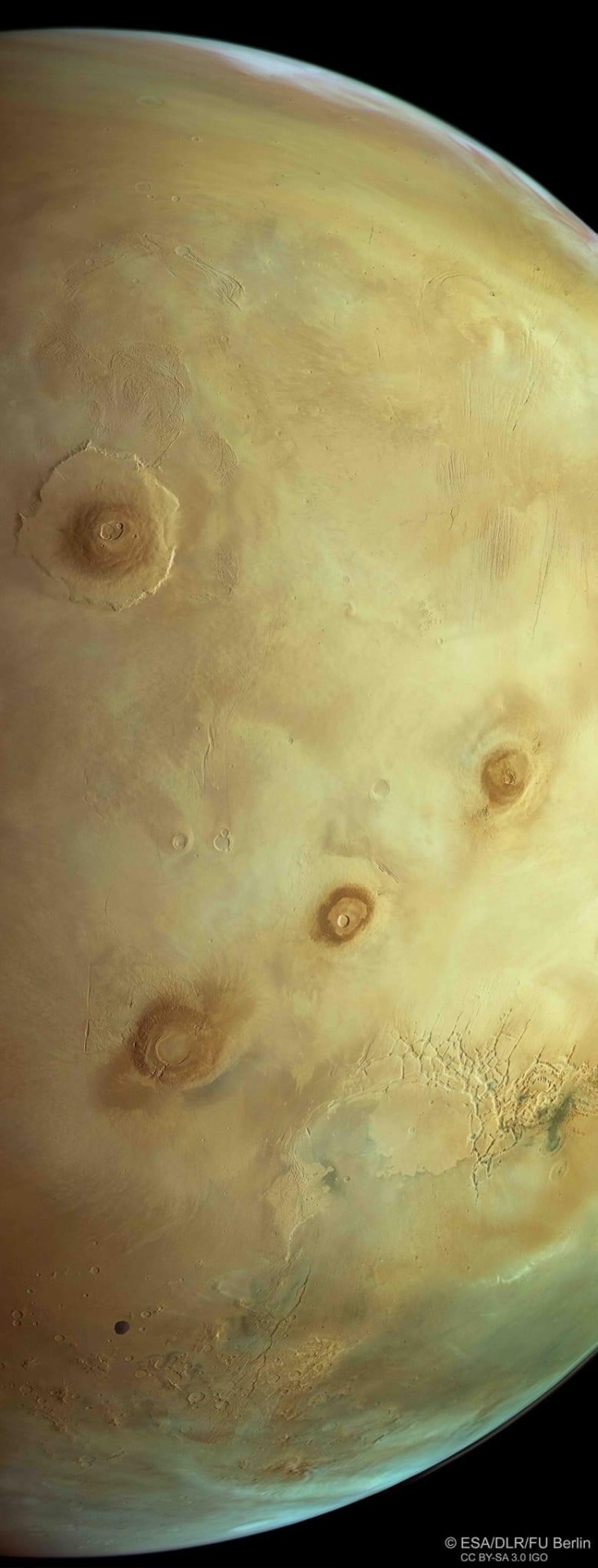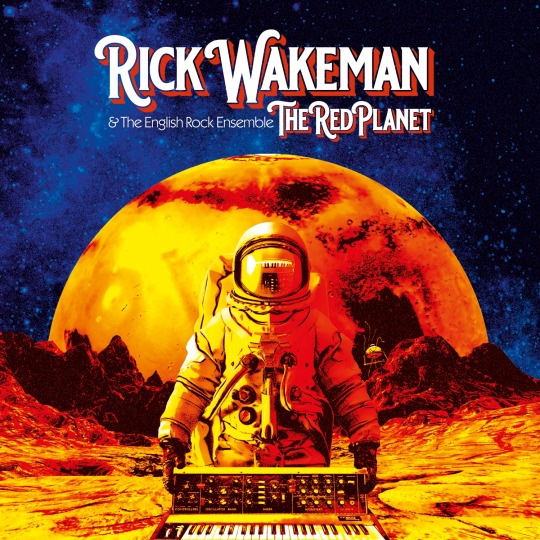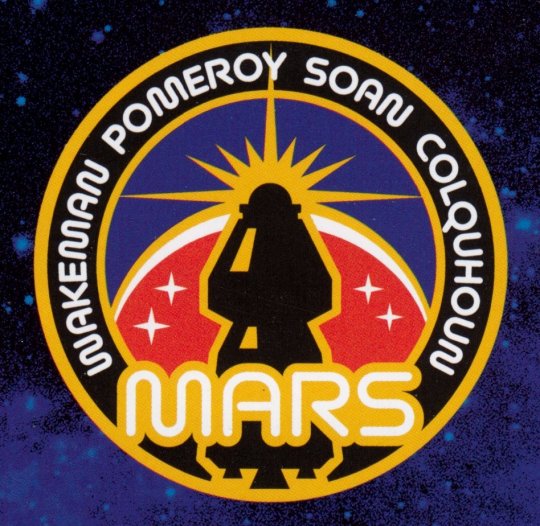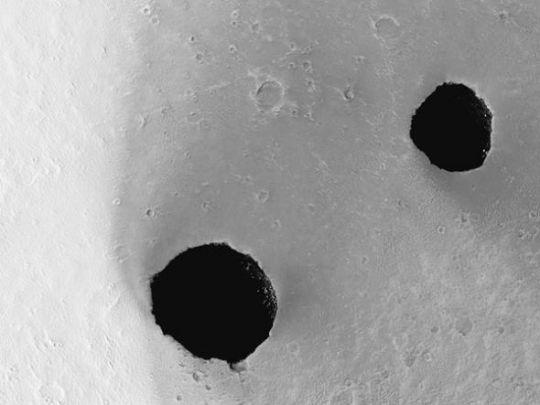#Ascraeus Mons
Explore tagged Tumblr posts
Text

Phobos Over Mars - October 15th, 1996.
"Hurtling through space a mere 3,000 miles above the Martian surface, the diminutive moon Phobos (below and left of the center) was imaged against the backdrop of a large shield volcano by the Viking 2 Orbiter in 1977. This dramatic picture looks down from the Orbiter's viewpoint about 8,000 miles above the volcano, Ascraeus Mons. Phobos itself is 5,000 miles below the Orbiter. North is toward the top with the Sun illuminating the scene from the South (black dots are reference marks). For scale, Ascraeus Mons is about 200 miles across at its base while asteroid-sized Phobos is about 15 miles in diameter. In this spectacular moon-planet image, volcanic calderas (craters) are visible at the summit of Ascraeus Mons - while impact craters on the sunlit side of Phobos' surface can also be seen!"
24 notes
·
View notes
Video
Perspective view of Mars’s Tharsis volcanoes by European Space Agency Via Flickr: This oblique perspective view shows a slice of Mars imaged to mark a milestone for ESA’s Mars Express: its 25 000th orbit around the Red Planet. It was generated from a digital terrain model and the nadir (downward-pointing) and colour channels of Mars Express’s High Resolution Stereo Camera. The vertical scale is exaggerated by a factor of approximately three, making the volcanoes look three times higher than they are in real life. Three of Mars’s famously colossal volcanoes are shown here: from left to right, Arsia, Pavonis and Ascraeus Mons. The mound of Mars’s largest volcano, Olympus Mons, can be spied further away at the top of the frame, while the fractured terrain of Noctis Labyrinthus, Mars’s ‘labyrinth of night’, can be seen in the foreground. Read more [Image description: This image shows a tan-coloured portion of Mars, with the curvature of the planet visible to the top left the frame. Four of Mars’s volcanoes can be seen in relief against the dark background, shown as darker mounds stretching away from the viewer.] Credits: ESA/DLR/FU Berlin, CC BY-SA 3.0 IGO
#ESA#European Space Agency#Space#Universe#Cosmos#Space Science#Science#Space Technology#Tech#Technology#Mars#Dunes#Panorama#Marte#Solar System#Sol#Mars Express#HRSC#High Resolution Stereo Camera#DLR#Red Planet#Exploration#Phobos#Volcano#Arsia Mons#Pavonis Mons#Ascraeus Mons#Olympus Mons#Noctis Labyrinthus#flickr
3 notes
·
View notes
Photo

8:18 PM EDT August 9, 2024:
Rick Wakeman - "Ascraeus Mons" From the album The Red Planet (June 19, 2020)
Last song scrobbled from iTunes at Last.fm
Thanks go out to The English Rock Ensemble, obviously.
--

1 note
·
View note
Text

I'm very comforted by the idea that somewhere on the slopes of ascraeus mons, there lives a 6'3 woman with callused hands and a husky voice who heats her coffee on the exhaust of the fusion reactor and knows how to cheat at poker by noticing the reflections in the helmet of someone's pressure suit.
#if your sci fi setting doesnt have rednecks in it it's woefully unrealistic#whenever there's a new place rednecks are gonna be the first ones to make it home#they're like lichen in this way
57 notes
·
View notes
Text

“Ascraeus Mons at Sunset on Mars” by Ren Wicks, late 1970s
143 notes
·
View notes
Photo

Topography of Ascraeus Mons by europeanspaceagency https://flic.kr/p/2ozjtKn
19 notes
·
View notes
Text
Inktober Day 7. Passport

Tharsis passport. For context, Tharsis is an ancient volcanic province in the north west of mars. The symbols on the sphere stand for: Olympus Mons (large symbol), Alba Mons (circle), and Arsia Mons, Pavonis Mons, and Ascraeus Mons, or the Tharsis Monte (3 triangles)
0 notes
Text


(Abrir imagen para apreciar la foto completa)
Hace 1 año el Mars Express celebraba 25.000 órbitas alrededor de Marte. Como parte de la celebración, el orbitador capturó una vista espectacular del Planeta Rojo para conmemorar la ocasión.
La nueva vista a gran altitud fue tomada por la cámara estéreo de alta resolución (HRSC) de Mars Express. Presenta muchos de los imponentes volcanes de Marte e incluso incluye una aparición sorpresa de la luna más grande del planeta, Fobos.
Mars Express llegó a Marte a finales de 2003 y completó su órbita número 25.000 el 19 de octubre de 2023. En las dos décadas transcurridas desde su llegada, el orbitador ha transformado completamente nuestra comprensión del planeta. Ha cartografiado la atmósfera de forma más completa que nunca, ha rastreado la historia del agua en la superficie de Marte, ha estudiado las dos pequeñas lunas marcianas con un detalle sin precedentes y ha proporcionado impresionantes vistas del planeta en tres dimensiones.
Esta nueva imagen no es una excepción. Se centra en la región de Tharsis, que cubre aproximadamente una cuarta parte de la superficie del planeta y alberga los famosos y colosales volcanes de Marte. Aquí se pueden ver muchos volcanes: Olimpo, Arsia, Pavonis y Ascraeus Mons, y Jovis, Biblis y Ulysses Tholus. Olympus Mons es el más grande y alcanza casi 22 km de altura (en comparación con los 8,8 km del Monte Everest aquí en la Tierra).
https://www.esa.int/Science_Exploration/Space_Science/Mars_Express/Mars_Express_celebrates_25_000_orbits
0 notes
Text
Woke White People and Privileged Kids UNLESS YOU'RE MARTIAN YOU CAN'T HAVE A USER NAME WITH A MARTIAN CONNECTION, EAT MARTIAN FOOD, LISTEN TO MARTIAN MUSIC, OR ENJOY MARTIAN MUSIC OR I WILL CALL YOU RACIST!
People who grew up on Mars, have Martian passports, and spend a lot of time with Martian people- whatever dude, I got to meet my Martian nana at Ascraeus Mons for dinner.
0 notes
Photo

Ascraeus Mons, Mars 2005
3 notes
·
View notes
Note
Also, that’s precisely the reason the volcanoes on Mars are enormous. Olympus Mons (as well as Pavonis Mons, Ascraeus Mons, and Arsia Mons) is a shield volcano, much like the Hawaiian Islands. Those islands formed by extremely hot and fluid lava erupting from a hot spot (an unmoving mantle plume, unlike the melting caused at plate boundaries which creates the types of volcanoes you find along the Ring of Fire, like Mt. Saint Helens for example) that spread over a wide area and built up over time as successive lava flows stacked on top of each other. However, because Earth has tectonic plates that move, eventually the crust over the hot spot moved over enough that one volcano went extinct and another began to form. On Mars, because the crust doesn’t move like it does on Earth, the mantle plume could go right on erupting and building up the shield for as long as it pleased, hence why you have a volcano the size of the state of Arizona. Gravity is also lower on Mars, so the lava could spread out further.
If earth is the only planet with tectonic plates, how come mars can have not only mountains but the biggest one in the solar system?
it used to have tectonic plates, but they’re locked in place now and the crust is fused solid.
#space#awesome geology#science!#tfw you have to curb your rambling to something short enough to keep attention and simple enough to not lose people#believe me i could write more about other types of volcanism on earth#or mars geology especially the tharsis region or valles marineris#also yes i did in fact know the names of the other volcanoes in the tharsis region#although i blanked on ascraeus mons and for the sake of posting quicker i just looked it up
219 notes
·
View notes
Photo

HiPOD 13 Oct 2021: Impact Craters as Windows to What Lies Beneath
Impact craters are common on all solar system bodies. They offer many clues to scientists regarding the geologic history of a planetary surface, particularly regarding its age, evolution with time, and composition.
For instance, this image covers an impact crater on the southeastern flank of Ascraeus Mons, a notable volcano in the Tharsis Plateau. Based on the original science rationale for acquiring this image, by gaining more information about its depth and consequently the stability of the crater wall we can learn more about the nature of the volcano’s flank materials.
Also, by carefully studying the materials exposed in the crater walls, we can gain more information about the subsurface.
Image is less than 5 km across and is 269 km above the surface.
NASA/JPL/UArizona
50 notes
·
View notes
Photo

7:56 PM EST February 3, 2024:
Rick Wakeman - "Ascraeus Mons" From the album The Red Planet (June 19, 2020)
Last song scrobbled from iTunes at Last.fm
Thanks go out to The English Rock Ensemble, obviously.
--

0 notes
Text
火星表面发现两个深坑最大直径超300米(图)
北京时间12月27日消息,据美国国家地理网站报道,美国宇航局2010年12月发布了火星侦察轨道飞行器HiRISE相机拍到的土星最新照片,显示了火星表面一些令人好奇的地质特征。每张照片都覆盖火星上跨度为3.7英里(约合6公里)的一片区域,揭示了火星表面小如办公桌的地质构造细节,其中,两个大坑最令科学家感兴趣。 1.火星表面大坑 火星表面大坑 在美宇航局火星侦察轨道飞行器(MRO)2010年10月1日和11月1日间拍摄的一张照片上,两个大坑就像太空蛞蝓的藏身之处一样,在火星火山艾斯克雷尔斯山(Ascraeus Mons)附近布满尘埃的平原留下了痕迹。一年前,火星侦察轨道飞行器的姊妹探测器“火星奥德赛”号(Mars…

View On WordPress
1 note
·
View note
Photo

Martian Landscape: Lava Channels-Collapsed lava tubes make snake-like tracks on the flank of the large volcano Ascraeus Mons on Mars.
61 notes
·
View notes
Photo

Martian Landscape: Lava Channels-Collapsed lava tubes make snake-like tracks on the flank of the large volcano Ascraeus Mons on Mars.
50 notes
·
View notes